“Compliance makes it riskier to do the wrong thing,” says Riaan Bekker, Force Solutions Manager, thryve – a risk management solutions provider.
And compliance assessments play a huge role in management of such risks to help your business save big.
How? You may ask.
Well, for starters let’s consider some hardcore, eye-opening data.
Non-adherence to General Data Protection Regulation (GDPR) compliance requirements cost companies $98.8 million in the first half of 2023.
This was a massive increase from $51.4 million, the GDPR fines tally from the same period of the previous year. Small, fledgling businesses all the way up to giants, such as Meta Platforms, suffered the consequences.
Meta was fined roughly $400 million for breaking EU data privacy laws for its treatment of children’s data on Instagram, the latest move by authorities in Europe and the U.S. related to child protection online.https://t.co/YUHL6hYRAC
— The New York Times (@nytimes) September 5, 2023
So, why is it that even well-established businesses are prone to compliance fiascos?
Well, there may be multiple factors at play. But, one of the biggest reasons companies fail to abide by regulations is this — poor compliance culture stemming from ineffective compliance assessment and training processes.
Ensuring your employees remain informed about compliance-related policies, procedures, laws, and regulations is crucial for compliance risk management and goes a long way toward avoiding the hefty penalties and reputation damage that come with non-compliance.
But how can you ensure that your compliance training programs are result-oriented and not just a tick-the-box exercise?
It’s simple.
Remember the rule that any successful training program begins and ends with assessments.
You need to conduct compliance assessments to test employees’ training needs and their understanding and retention of the information you provide.
Once you’re done reading this blog, you’ll know everything about leveraging online assessments for compliance success. We’ll start by learning more about employee compliance assessments and their benefits, then dive into how you can create and conduct your assessments online.
Let’s begin.
What Are Employee Compliance Assessments?
Employee compliance assessments test an employee’s understanding of government laws, rules & regulations, and company policies & procedures pertaining to compliance matters. Such assessments may include objective-type questions, such as multiple choice, fill-in-the-blanks, true/false, etc., or open-ended, essay-style questions.
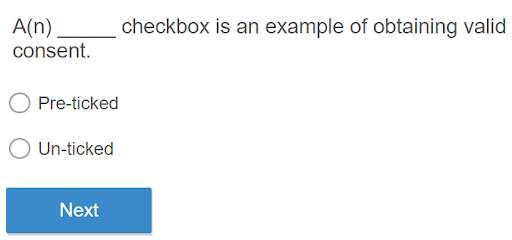
Compliance assessments serve as a way to identify compliance training needs, boost knowledge comprehension, and much more. Your it outsourcing provider can also help identify compliance training needs.
Let’s learn more about this in the next section.
?Did you know?
A KPMG report has revealed that 55% of chief compliance officers consider it a top compliance challenge to promote awareness of compliance responsibilities across the enterprise.
How Online Assessments Help Maintain Compliance
Online quizzes and assessments play various roles in a compliance training and management program, making them indispensable for businesses across all industries. Here are the top benefits of employee compliance assessments:
-
Measure employee-related compliance risk
Conducting company-wide employee compliance assessments can give you a good understanding of your employee-related compliance risk and pain points. You can use such assessments to complement your other compliance risk assessment measures and efficiently allocate resources to your compliance management initiatives.
-
Deliver effective & streamlined compliance training
Assessments help improve compliance training for your employees and partners in multiple ways.
- Compliance gap assessments enable you to accurately identify training needs before the training is delivered so you can provide the right training to the right people in the first attempt. This reduces your training cost and time investment.
- They let you quickly spot and address remaining knowledge gaps after the training while also providing insights into learning challenges.
- Interspersing quizzes throughout the training helps make it more engaging and promotes a culture of learning, which are among the biggest learning & development challenges worldwide.
-
Refresh knowledge with engaging quizzes
The process of ensuring employee compliance doesn’t stop at training. You also need to make sure that employees don’t forget what they’ve learned. To that end, conducting refresher quizzes and tests works even better than retraining.
You can start conducting refresher quizzes as soon as the training is over and repeat them as often as necessary to maintain continuous compliance.
But how often should you give such refresher assessments?
Here’s what learning expert Matthew Tang says:
- Frequency should be based on the nature of the job/task
High risk areas may be more appropriate for monthly, formal assessments. Lower risk areas may be more informal and less frequent. For example:
High risk area – Hospital setting: Infection prevention is very important here. Infection prevention compliance should be frequently re-visited through formal assessments, job aids (like the hand washing posters in bathrooms), and manager observations. Infection prevention is directly tied to the mortality rate so people are literally dying if employees are not in compliance.
High risk area – Retail store: Any place that uses cleaning chemicals and annually requires OSHA training to all employees to make sure chemicals are stored and handled safely. The store has clear procedures so only maintenance employees handle the chemicals, so sales employees never touch the chemicals. In this case, it might not be worth to have frequent testing of sales employees.
- Frequency should be based on past performance
For example, if a company is dealing with a recent injury or sexual harassment complaints, monthly coaching, assessments, training makes sense.
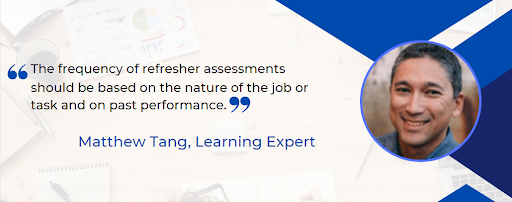
-
Demonstrate commitment to compliance
Conducting assessments is a great way to show your commitment to compliance to auditors and regulators. In fact, some regulators, such as the US Federal Deposit Insurance Corporation (FDIC), mandate periodic assessments after compliance training.
“Once personnel have been trained on a particular subject, a compliance officer should periodically assess employees on their knowledge and comprehension of the subject matter.”
~ FDIC Consumer Compliance Examination Manual
- Hire informed, safety-minded employees
When hiring for high-risk jobs, such as various roles in manufacturing or construction, you can use assessments to ensure that the candidate is well-aware of and committed to complying with government safety standards.
Similarly, if you’re hiring for a finance role, you can conduct assessments to find out about candidates’ knowledge of anti-money laundering, customer due diligence, etc.
Top 10 Compliance Assessments
Below are some of the most commonly conducted compliance assessments. Some of these apply to all types of businesses, while others are industry-specific.
1. OSHA Safety & Health Assessments
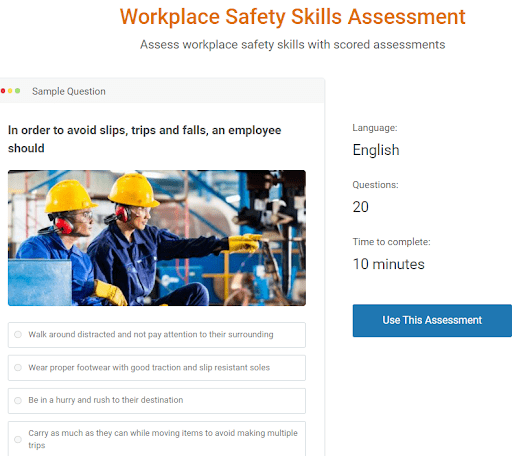
The Occupational Safety & Health Administration (OSHA) sets workplace health and safety standards across various industries, such as the general industry, construction, maritime, and agriculture.
Depending on your industry, you may need to conduct OSHA safety compliance assessments on topics such as hazard identification & risk assessment, bloodborne pathogens, fall protection, forklift safety, etc.
2. GDPR Knowledge Assessment
The General Data Protection Regulation (GDPR) is the world’s strictest data privacy & security law. While introduced by the European Union, the legislation extends to any organization that collects or targets data related to EU citizens.
The GDPR Knowledge Assessment tests the learner’s understanding of key data protection principles and individual rights pertaining to personal data.
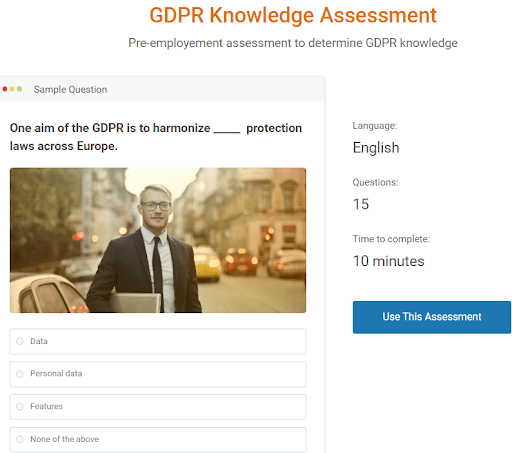
3. OSHA Injury & Illness Recordkeeping Skills Assessment
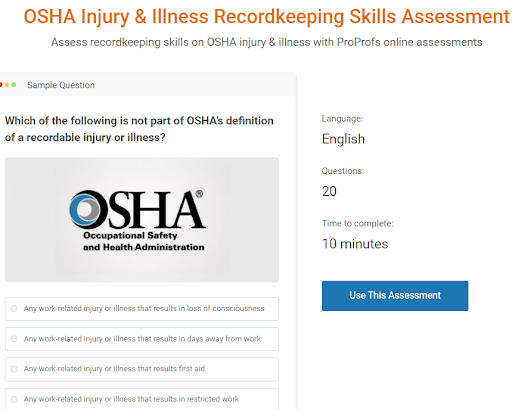
OSHA requires employers with more than ten employees to maintain a record of all serious, work-related employee injuries and illnesses. The OSHA Injury & Illness Recordkeeping Skills Assessment tests knowledge of the types of injuries and illnesses that need to be recorded and the type of information that must be there in such records.
4. HIPAA Privacy & Security Standards Skills Assessment
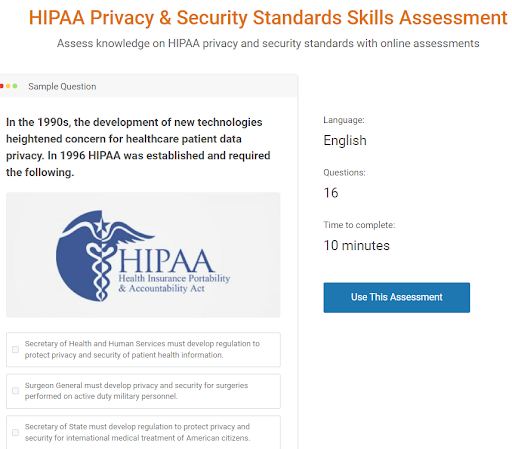
The Health Insurance Portability and Accountability Act (HIPAA) safeguards the privacy and security of healthcare data. The HIPAA Privacy & Security Standards Skills Assessment is designed to test the members of a healthcare organization on their understanding of the HIPAA act and what they can do to protect sensitive medical information from theft, loss, breaches, and compromise.
5. Sexual Harassment Awareness Assessment
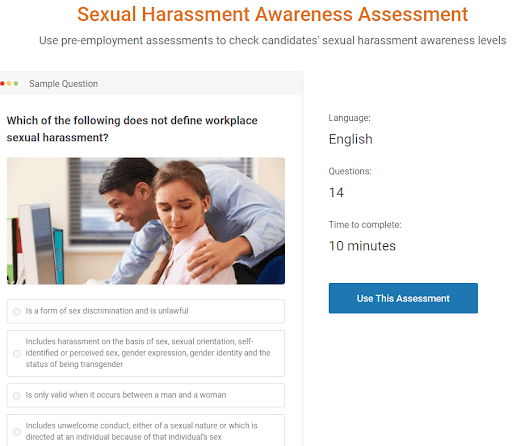
This assessment tests employees’ knowledge of what constitutes workplace sexual harassment and how to prevent sexual harassment in any form.
6. FMLA Administration Skills Assessment
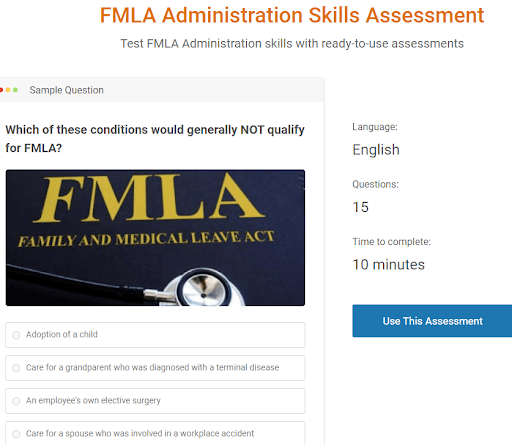
The Family and Medical Leave Act (FMLA) is a US law that allows eligible employees to take unpaid, job-protected leaves for certain family and medical reasons. The assessment above tests managers’ knowledge of FMLA-related topics, such as determining FMLA leave eligibility, how to administer FMLA leaves, etc.
7. Fair Labor Standards Act Skills Assessment
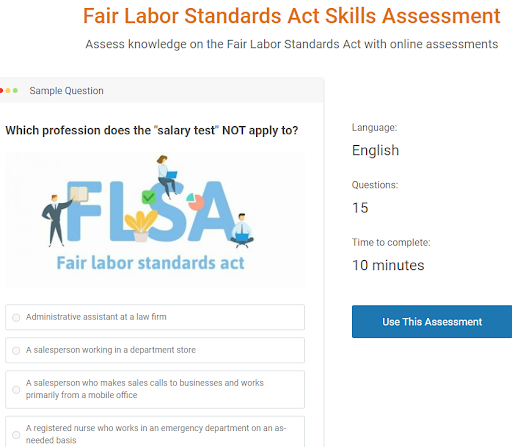
This assessment tests HR professionals’ and managers’ knowledge of the Fair Labor Standards Act (FLSA), the provisions for minimum wage, overtime pay, etc., and FLSA’s recordkeeping and child labor regulations.
8. Diversity, Equity & Inclusion Assessment
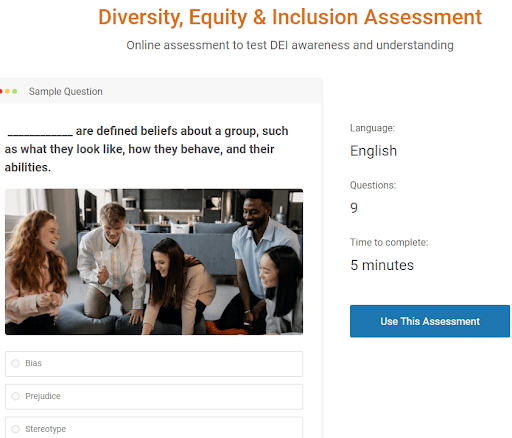
This assessment tests employees’ and managers’ understanding of diversity, equity, and inclusion, its importance, and how to successfully implement a DEI culture and mindset in the organization.
9. Anti-Money Laundering & Counter-Terrorist Financing Assessment
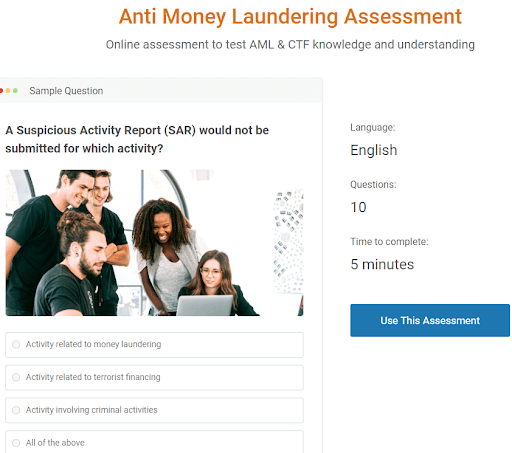
Anti-Money laundering and counter-terrorist financing are among the biggest compliance matters in the financial sector. The AML & CTF assessment tests employees’ knowledge of money laundering, terrorism financing, and the US Bank Secrecy Act.
10. Discrimination in the Workplace Knowledge Assessment
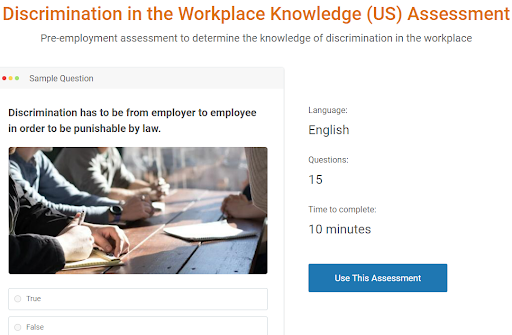
A compliance assessment on workplace discrimination tests employees’ knowledge and understanding of what constitutes discrimination and the government’s anti-discrimination laws.
Other Important Compliance Assessments for Employees
- Customer Due Diligence (CDD)
- Accessibility for Ontarians with Disabilities Act (AODA)
- California Consumer Privacy Act (CCPA) for data protection
- Payment Card Industry Data Security Standard (PCI DSS)
Now that you know about the importance of employee assessments for compliance and the types of assessments you can create let’s look at the process for creating a compliance assessment using online quiz software.
How to Create a Compliance Assessment Online
Here’s how to use an online compliance assessment tool to quickly and easily create employee assessments on compliance subjects.
Step 1 – Pick a pre-built assessment or create one from scratch.
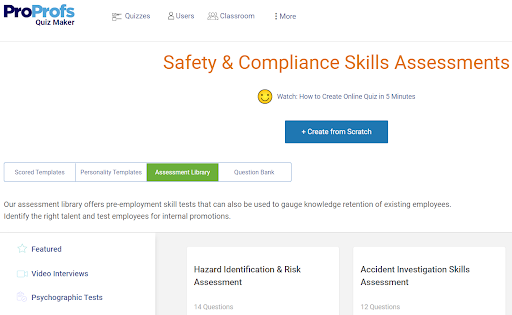
Step 2 – Add a title & welcome screen description.
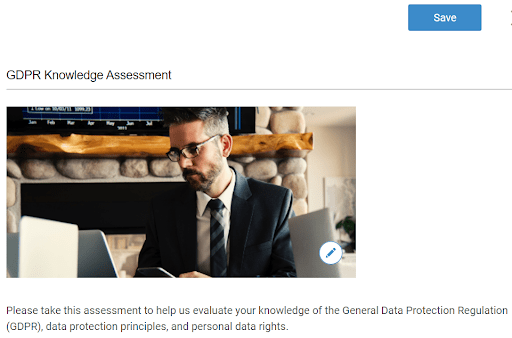
Step 3 – Create questions or import them from the question bank.
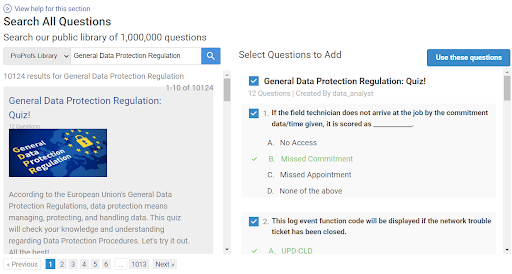
Step 4 – Configure security & anti-cheating settings.
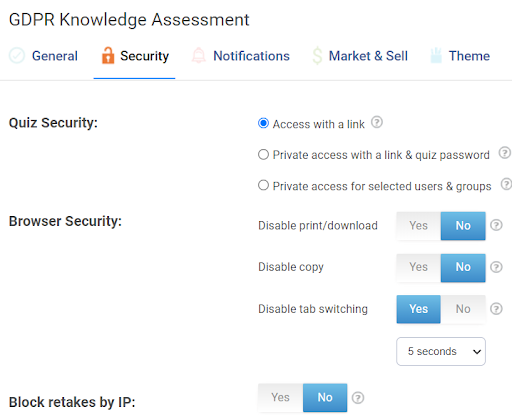
Step 5 – Set up the certification program.
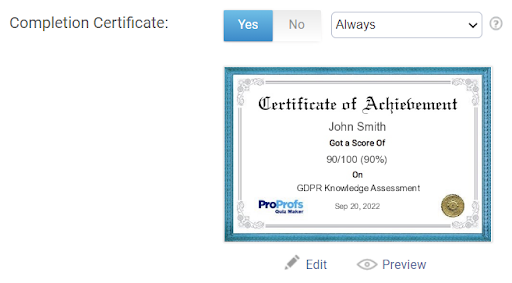
Watch: How to Create an Assessment Online
And you’re done!
Learn More: Check out our quiz maker guide for an in-depth look at how to create an assessment.
Compliance Assessment Best Practices
There are some things that you need to keep in mind while creating and conducting online assessments for compliance, to implement an effective employee compliance assessment process.
-
Educate employees on the assessment
Employees must be clear on the “why” of the assessment before attempting it. So, you need to communicate the reasons for conducting the assessment before deploying it. You can provide this information orally, via email, or add it to the assessment’s description.
Besides talking about the compliance requirements, you can also mention how taking the assessment will benefit them personally. For example, taking an OSHA compliance program assessment can help employees stay safe and healthy at work.
-
Ask questions in a simple & clear way
Using straightforward language in organizational compliance assessments ensures that employees understand each question properly. On the other hand, asking trick questions or asking questions in a complicated way can result in the learner misunderstanding the question or answering the question randomly to quickly move on to the next one.
-
Make it visual and engaging
Adding images and videos to your compliance training assessment is a great way to engage assessment takers and ensure they attempt the assessment carefully. You can also add videos to provide information when you’re using quizzes as part of your compliance training course.

Another thing you can do to make your assessments more engaging is include questions in different formats, such as multiple-choice, check-box, fill-in-the-blanks, order list, etc.
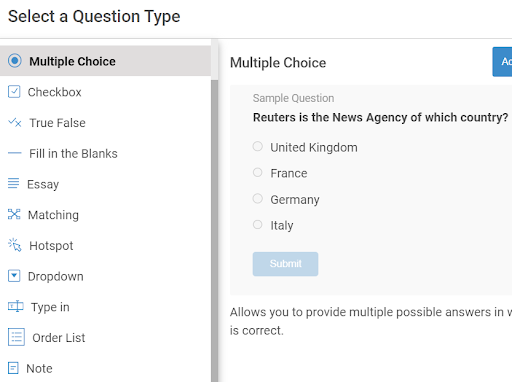
Pro Tip: You can also include questions that feature a case study or real-life scenario to allow learners to relate better to your assessment.
-
Include audio/video response questions
The audio/video response question type lets quiz takers respond to an open-ended question by recording an audio clip or video. Audio/video response questions enable compliance managers to get deep insights into employees’ knowledge while making it easier for the quiz takers to respond to essay-style questions.
Such questions also serve as an effective way to interview job candidates remotely. So, these can help you hire people with good knowledge of the compliance requirements in your industry.
Watch: How to Create a Video Interview Question
-
Set up a certification/recertification program
Adding a certification program to your compliance assessments not only helps in engaging learners but also in maintaining continuous compliance. You can set passing scores for certification along with a certificate expiry date. You can also request retakes on certification expiration.
You can automate the entire process using online quiz software and set up reminders to ensure employees take/retake assessments on a timely basis.
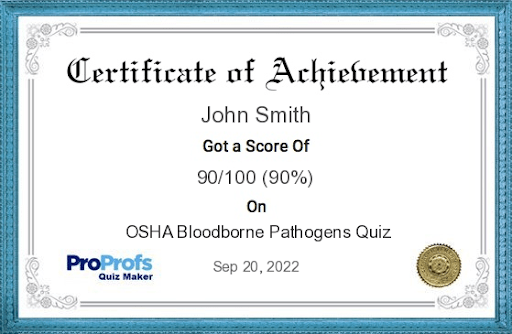
-
Configure security & anti-cheating settings
Setting up security and cheating-prevention mechanisms for your assessments maintains the integrity and credibility of your assessments. Some of the settings you can use for this are:
- Adding password protection and user authentication to your assessments
- Enabling remote proctoring functionalities
- Disabling tab/browser switching
- Randomizing the order of questions and answer options
- Creating a pool of questions to present a different, random set of questions to each learner
- Adding time limits to assessments/individual questions
- Disabling copying/printing of assessment content
Watch: How to Create a Timed Quiz
Did You Know?
In June 2022, the Securities and Exchange Commission charged Ernst & Young LLP (EY) $100 Million for cheating by its audit professionals on exams required to obtain and maintain Certified Public Accountant (CPA) licenses. It was the largest penalty ever imposed by SEC against an audit firm.
-
Provide instant question feedback
Providing feedback/explanation for a question as soon as a learner answers it’s excellent for reinforcing learning. That’s when learners would be most eager to know the correct answer along with any related information.
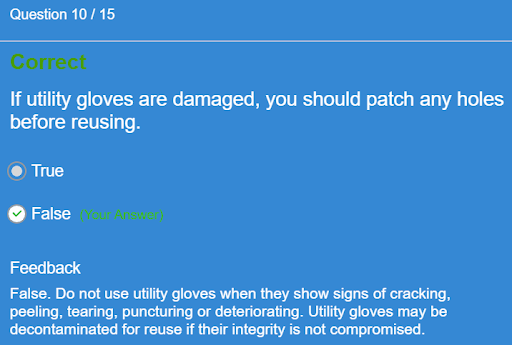
-
Enable comments
Enabling comments lets you ask the assessment taker to explain why they chose an answer option before moving on to the next question. This way, you can discourage them from selecting options at random.
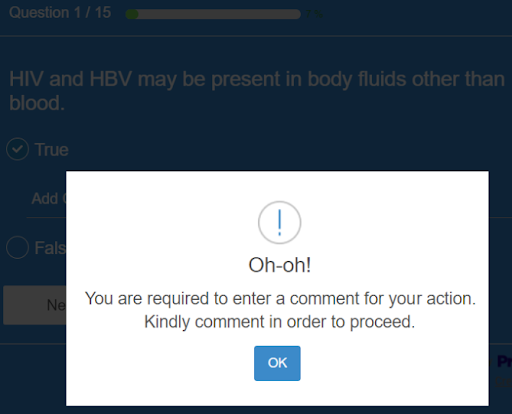
-
Provide personalized feedback
Besides providing instant feedback on a question level, it would also be a good idea to give personalized, overall feedback that can help employees self-assess their learning gaps and work on bringing their knowledge up to the required standards. You can provide this feedback in text form or as a short video or audio clip.
-
Analyze reports by team and location
Once you’re done analyzing individual reports for your compliance assessment, you must also analyze group-level performance according to the team, location, etc., to assess the effectiveness of your training programs and recommend any changes to them if needed.
You can do this easily by using a virtual classroom environment to administer your assessments. Doing so lets you create learner groups to view group reports.
Watch: How To Set up Your Virtual Classroom in 5 Minutes
-
Provide links to learning resources on assessment completion
Like providing instant feedback, adding learning resource links to assessment results is another excellent way to strike when the iron is hot. You can redirect learners to your training material, web pages detailing compliance standards, or even another quiz on regulatory compliance.
Pro Tip – You also create and link to a knowledge base that features all information about regulatory compliance, safety, and important policies and procedures. Your employees and partners can refer to your knowledge base anytime they have a doubt regarding a compliance matter.
-
Assess third parties as well
Your employees aren’t the only ones you need to train and assess on compliance requirements. You can also face business risks stemming from your third-party relationships.
Third-party compliance risk doesn’t get as much attention as can be seen from the numbers below, but it’s just as important in maintaining a business’ reputation.
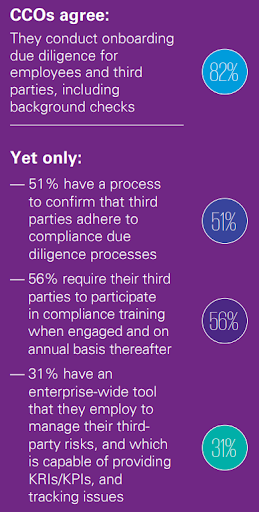
You can use online assessments created with a scalable assessment solution, such as ProProfs, to assess your third parties’ compliance awareness in a streamlined and efficient way.
-
Keep your assessments updated
To keep your assessments relevant, you must review your questions periodically. You must also do this whenever there is a change in government regulations and when you introduce new products or make major changes to existing ones.
-
Use good compliance assessment software
The effectiveness of your assessments largely depends on the assessment software you choose to create and deploy them. Excellent assessment tools come with all the features you need to create highly insightful and customized assessments.
For example, ProProfs assessment software lets you add branching logic to your assessments and tag your questions, so you can see how an assessment taker scored on individual topics.
Here are the features you need to look for when deciding on your assessment platforms.
- Diverse question types: To keep assessments engaging and assess in different ways
- Automated scoring: To save time on score marking
- Flexible feedback mechanisms: To make learners understand concepts easily
- Ready-to-use assessments, assessment templates, and questions: To save time and get more ideas
- Online classroom functionality: For easy learner management
- Advanced reporting and analytics mechanism: To get a 360 degree view of how your learners are doing
- Settings to prevent cheating, customize your assessment, manage certification, and automate notifications
Watch: How to Choose the Best Assessment Software
Build and Maintain a Culture of Compliance
Embracing a culture of compliance at all levels is key to maintaining adherence to laws and regulations. Conducting regular compliance assessments for your employees plays a critical role in this. Assessments enable you to find out how informed your workforce is as a whole, tailor compliance training programs, and help promote accountability and self-learning.
You can get all these benefits and empower your compliance journey if you have the right compliance assessment tool to support your initiatives. ProProfs makes it easy to create and conduct compliance assessments at scale. Its simple yet feature-rich assessment platform features 100+ professionally-designed knowledge tests and over a million ready-to-use questions.
FREE. All Features. FOREVER!
Try our Forever FREE account with all premium features!





